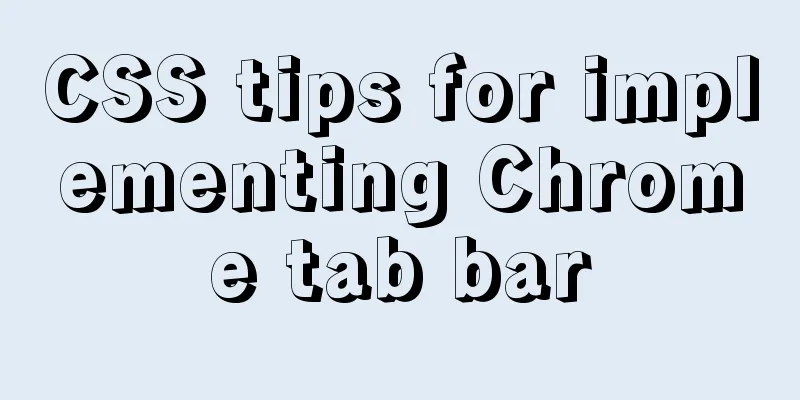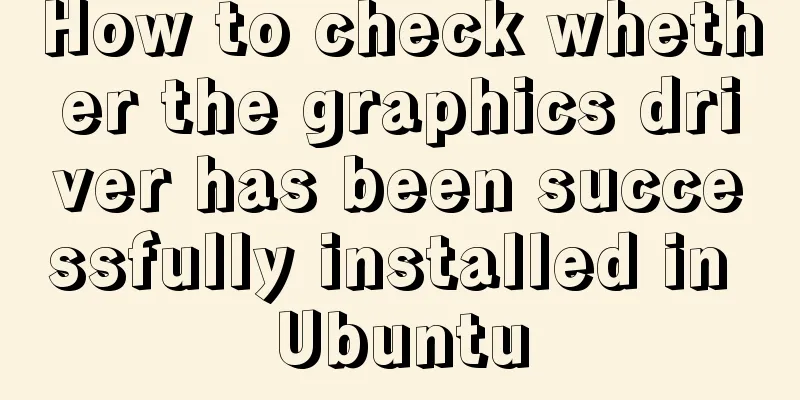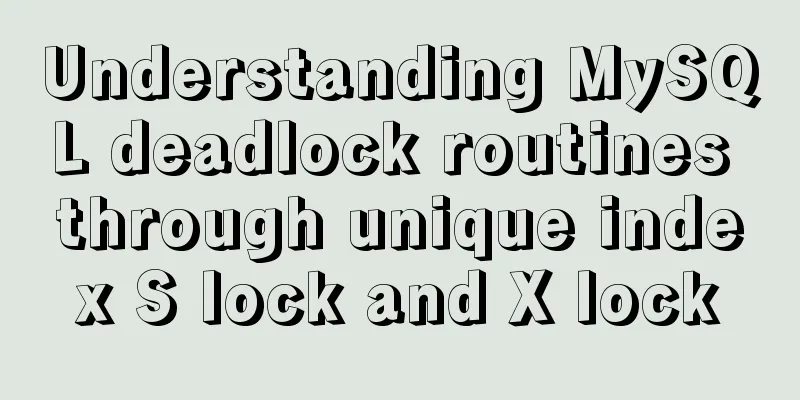CSS tips for implementing Chrome tab bar

|
This time let’s look at a navigation bar layout with special rounded corners, such as the tab bar of Google Chrome:
How to achieve such a layout? Here are a few methods 1. Pseudo-element splicingAssume there is such an HTML structure <nav class="tab"> <a class="tab-item">Svelte API</a> <a class="tab-item active">Svelte API</a> <a class="tab-item">Svelte API</a> <a class="tab-item">Svelte API</a> </nav> The first method that can be considered is to use two pseudo elements to splice
The rounded corners in the middle are relatively easy, but how to achieve the reverse rounded corners on the left and right sides? In fact, you can think about what styles can be used to achieve a circle. Here I think of border-radius, which can be achieved like this
The following is an example
The code to achieve this is
.tab-item{
position: relative;
background-color: red;
padding: 10px 15px;
border-radius: 12px 12px 0 0;
cursor: pointer;
transition: .2s;
}
.tab-item::before,.tab-item::after{
position: absolute;
bottom: 0;
content: '';
width: 20px;
height: 20px;
border-radius: 100%;
box-shadow: 0 0 0 40px red;/*Using box-shadow does not affect the size*/
transition: .2s;
}
.tab-item::before{
left: -20px;
clip-path: inset(50% -10px 0 50%);
}
.tab-item::after{
right: -20px;
clip-path: inset(50% 50% 0 -10px);
}The final real-time effect is as follows
Here, clipping is achieved using clip-path. Note that you can clip a little more inwards to avoid gaps in the stitching. To complete the code, visit chrome-tab (codepen.io) Of course, the reverse rounded corners here can also be achieved using radial gradient, so let’s continue reading. 2. Universal Gradient CSS gradients are almost omnipotent and can draw any graphics. Here we can split them into two rectangles, two circles, and two reverse rounded corners, that is, 2 linear gradients and 4 radial gradients, as shown below.
The code to achieve this is
.tab-item{
padding: 10px 35px;
background-image:
radial-gradient(circle at 0 0, transparent 15px,blue 0),
radial-gradient(circle at 0 0, transparent 15px,blue 0),
radial-gradient(circle at 0 0, green 12px, transparent 0,
radial-gradient(circle at 12px 0, green 12px, transparent 0,
linear-gradient(red,red),
linear-gradient(red,red);
background-repeat: no-repeat;
background-position: 15px top, right 15px top 0, left bottom, right bottom, center bottom, center, bootom;
background-size: 30px 30px, 30px 30px, 12px 12px, 12px 12px, calc(100% - 30px) calc(100% - 12px), calc(100% - 54px) 100%;
}Although it is implemented, it is very long-winded. After careful observation, it is found that the two circles can be realized by tiling. The two reverse fillets can be regarded as a semicircle, which can also be tiled, as shown below
In this way, only two radial gradients are needed to achieve it. The code is as follows
.tab-item{
position: relative;
padding: 10px 35px;
cursor: pointer;
background-image: radial-gradient(circle at 15px 0, transparent 15px,blue 0),
radial-gradient(circle at 27px 12px, green 12px, transparent 0),
linear-gradient(red,red),
linear-gradient(red,red);
background-size: 100% 15px,calc(100% - 54px), calc(100% - 30px) calc(100% - 12px), calc(100% - 54px) 100%;
background-position: -15px bottom, left top, center bottom, center bottom;
background-repeat: repeat-x, repeat-x, no-repeat, no-repeat;
}The final real-time effect is as follows (the above is the schematic diagram)
Complete code can be found at chrome-tab-gradient (codepen.io) 3. Adaptive SVGAlthough gradients are versatile, they require a lot of code and are very demanding on your patience. For this example, svg is also a good solution.
The rounded rectangle in the middle is easier, just use rect <svg xmlns='http://www.w3.org/2000/svg' width='100%' height='100%'> <rect rx="12" width='100%' height='100%' fill="#3A8EFF"/> </svg> The reverse rounded corners on both sides can be directly created using a path (which can be generated by various graphics software) <svg width="100" height="100" viewBox="0 0 100 100" fill="none" xmlns="http://www.w3.org/2000/svg"> <path fill-rule="evenodd" clip-rule="evenodd" d="M0 100C55.2285 100 100 55.2285 100 0V100H0Z" fill="#3A8EFF"/> </svg> <svg width="100" height="100" viewBox="0 0 100 100" fill="none" xmlns="http://www.w3.org/2000/svg"> <path fill-rule="evenodd" clip-rule="evenodd" d="M100 100C44.7715 100 0 55.2285 0 0V100H100Z" fill="#3A8EFF"/> </svg> Then use these three svg codes as the background. You can use background-size and background-position to adjust and control them.
.tab-item{
position: relative;
padding: 10px 35px;
margin: 0 -15px;
cursor: pointer;
transition: .2s;
background-image: url("data:image/svg+xml,%3Csvg width='100' height='100' viewBox='0 0 100 100' fill='none' xmlns='http://www.w3.org/2000/svg'%3E%3Cpath fill-rule='evenodd' clip-rule='evenodd' d='M100 100C44.772 100 0 55.228 0 0v100h100z' fill='%23F8EAE7'/%3E%3C/svg%3E"),
url("data:image/svg+xml,%3Csvg width='100' height='100' viewBox='0 0 100 100' fill='none' xmlns='http://www.w3.org/2000/svg'%3E%3Cpath fill-rule='evenodd' clip-rule='evenodd' d='M0 100c55.228 0 100-44.772 100-100v100H0z' fill='%23F8EAE7'/%3E%3C/svg%3E"),
url("data:image/svg+xml,<svg xmlns='http://www.w3.org/2000/svg'><rect rx='12' width='100%' height='100%' fill='%23F8EAE7'/></svg>");
background-size: 12px 12px, 12px 12px, calc(100% - 24px) calc(100% + 12px);
background-position: right bottom, left bottom, center top;
background-repeat: no-repeat;
}The real-time effect is as follows
The full code can be found at chrome-tab-svg (codepen.io) In addition, some people may wonder why three segments of SVG are used here? Can't I use 1 svg to contain 3 paths? **The answer is no. There is no way to use positioning flexibly in SVG. For example, if you want to place it in the lower right corner, SVG can only use 100% instead of calc (100% - 12px), not to mention that CSS also has positioning attributes such as right bottom, so CSS multiple backgrounds must be used to achieve it. 4. Picture borderThe above methods are still too complicated. Can we "cut the picture"? Of course it is possible, but it also requires certain skills to achieve adaptation. CSS3 border-image can be used here to achieve this. For information about border-image, please refer to this article: JELLY | Correct usage of border-image (jd.com). Just prepare a picture like this, svg or png will do
svg is as follows <svg width="67" height="33" viewBox="0 0 67 33" fill="none" xmlns="http://www.w3.org/2000/svg"> <path fill-rule="evenodd" clip-rule="evenodd" d="M27 0c-6.627 0-12 5.373-12 12v6c0 8.284-6.716 15-15 15h67c-8.284 0-15-6.716-15-15v-6c0-6.627-5.373-12-12-12H27z" fill="#F8EAE7"/> </svg> Then just cut it according to the border-image specification
The code is implemented as follows, remember to add border
.tab-item{
position: relative;
padding: 0 8px;
margin: 0 -15px;
cursor: pointer;
border-width: 12px 27px 15px;
border-style: solid;
border-image: url("data:image/svg+xml,%3Csvg width='67' height='33' viewBox='0 0 67 33' fill='none' xmlns='http://www.w3.org/2000/svg'%3E%3Cpath fill-rule='evenodd' clip-rule='evenodd' d='M27 0c-6.627 0-12 5.373-12 12v6c0 8.284-6.716 15-15 15h67c-8.284 0-15-6.716-15-15v-6c0-6.627-5.373-12-12-12H27z' fill='%23F8EAE7'/%3E%3C/svg%3E") 12 27 15 fill;
}The real-time effect is as follows
The full code can be found at chrome-tab-border-image (codepen.io) Although the code implementation is relatively simple, the content size is difficult to control due to the need to add borders. 5. MaskThe previous methods of using background images actually have a problem. The colors are all in the background image and are almost fixed, making it inconvenient to modify. So, with the help of mask, this problem can be easily solved. With the previous background (gradient or svg is fine), you only need to batch change the background to -webkit-mask, like this
Taking svg as an example, the replacement is as follows
.tab-item{
position: relative;
padding: 10px 35px;
cursor: pointer;
background: #F8EAE7;
-webkit-mask-image: url("data:image/svg+xml,%3Csvg width='100' height='100' viewBox='0 0 100 100' fill='none' xmlns='http://www.w3.org/2000/svg'%3E%3Cpath fill-rule='evenodd' clip-rule='evenodd' d='M100 100C44.772 100 0 55.228 0 0v100h100z' fill='%23F8EAE7'/%3E%3C/svg%3E"),
url("data:image/svg+xml,%3Csvg width='100' height='100' viewBox='0 0 100 100' fill='none' xmlns='http://www.w3.org/2000/svg'%3E%3Cpath fill-rule='evenodd' clip-rule='evenodd' d='M0 100c55.228 0 100-44.772 100-100v100H0z' fill='%23F8EAE7'/%3E%3C/svg%3E"),
url("data:image/svg+xml,<svg xmlns='http://www.w3.org/2000/svg'><rect rx='12' width='100%' height='100%' fill='%23F8EAE7'/></svg>");
-webkit-mask-size: 12px 12px, 12px 12px, calc(100% - 24px) calc(100% + 12px);
-webkit-mask-position: right bottom, left bottom, center top;
-webkit-mask-repeat: no-repeat;
}Now it is easy to control the background color. If you need to change the background color, just change it directly.
.tab-item:hover{
background: #F2D0CA;
}The full code can be found at chrome-tab-mask (codepen.io) In addition, if you like **"cutting pictures"**, you can also use mask-border, which is basically the same as border-image above, but with a masking effect. Or use this picture to cut
The code implementation is
.tab-item{
/*...*/
-webkit-mask-box-image: url("data:image/svg+xml,%3Csvg width='67' height='33' viewBox='0 0 67 33' fill='none' xmlns='http://www.w3.org/2000/svg'%3E%3Cpath fill-rule='evenodd' clip-rule='evenodd' d='M27 0c-6.627 0-12 5.373-12 12v6c0 8.284-6.716 15-15 15h67c-8.284 0-15-6.716-15-15v-6c0-6.627-5.373-12-12-12H27z' fill='%23F8EAE7'/%3E%3C/svg%3E") 12 27 15;
}
The full code can be found at chrome-tab-mask-border (codepen.io) Currently still in draft, there is an alternative property -webkit-mask-box-image that can be used VI. Summary and explanationThe above introduces 5 different layout methods. The following summarizes the key points of implementation:
This is the end of this article about the techniques of implementing Chrome tab bar with CSS. For more relevant CSS Chrome tab bar content, please search 123WORDPRESS.COM’s previous articles or continue to browse the related articles below. I hope you will support 123WORDPRESS.COM in the future! |
<<: How to play local media (video and audio) files using HTML and JavaScript
>>: HTML drag and drop function implementation code
Recommend
Three uses and differences of MySQL not equal
Judgment symbols are often used in MySQL, and not...
Detailed explanation of nginx anti-hotlink and anti-crawler configuration
Create a new configuration file (for example, go ...
Study on using characters instead of pictures to achieve rounded or sharp corners
Please see the following screenshot I took from G...
MySQL 8.0.19 supports locking an account after entering an incorrect password three times (example)
MySQL 8.0.19 supports locking the account after e...
How to implement animation transition effect on the front end
Table of contents Introduction Traditional transi...
Solution to mysql prompt "got timeout reading communication packets"
Error message: user: 'root' host: `localh...
Teach you how to use MySQL8 recursive method
I have previously written an article about recurs...
Solution to automatically trigger click events when clicking on pop-up window in Vue (simulation scenario)
Business scenario: Use vue + element ui's el-...
CSS Sticky Footer Implementation Code
This article introduces the CSS Sticky Footer imp...
A brief introduction to Tomcat's overall structure
Tomcat is widely known as a web container. It has...
Vue+thinkphp5.1+axios to realize file upload
This article shares with you how to use thinkphp5...
Eclipse configures Tomcat and Tomcat has invalid port solution
Table of contents 1. Eclipse configures Tomcat 2....
Implementation of nginx virtual host settings based on domain name, port, and different IP
1. Setting up nginx virtual host With virtual hos...
Detailed explanation of how MySQL solves phantom reads
1. What is phantom reading? In a transaction, aft...
A brief discussion on the VUE uni-app development environment
Table of contents 1. Through HBuilderX visual int...
























